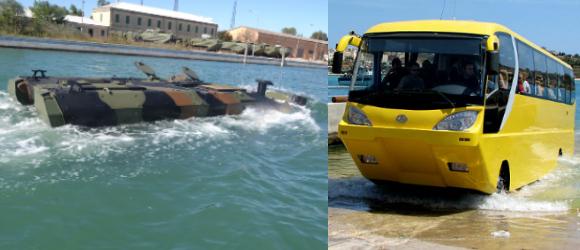Sky, sea and land, but leaving sky to aeronautical skills, with this article I would like to propose something unusual with respect to the usual "terrestrial" military vehicle.
In fact, aid to the populations does not always arrive by land. When it doesn't even arrive by air, it means that we are dealing with them, the amphibious machines. A somewhat niche and perhaps little-known sector, but certainly at the forefront when it comes to saving lives, perhaps following a flood.
It should be assumed that the idea of an amphibious vehicle goes back - apart from the usual Leonardo da Vinci that invented almost everything before others - to the 1781 with a steam engine designed by S. Bentham but its real debut can be placed during the second world war for military purposes; however after that, amphibious vehicle applications have also increased for humanitarian purposes and think a bit ... even tourists, as we will read later.
Amphibians, not only on wheels but also on tracks, and when they emerge from the waterways with their masses they leave us surprised and fascinated by how they face the challenges of physics, even more when we observe them in off-road performance, climb everywhere with their big and dotted tires rather than tracks.
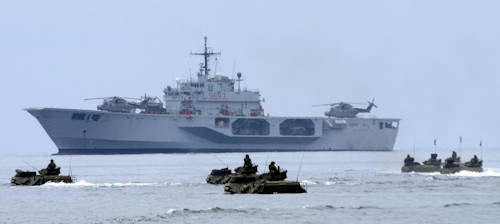 In the military field they are used by elite departments as in the case of the San Marco regiment with the AAV-7 - 22 tonne amphibious assault vehicle but in this article I will deal with some types made in Italy, perhaps less prominent but certainly always at the forefront of aid to the populations.
In the military field they are used by elite departments as in the case of the San Marco regiment with the AAV-7 - 22 tonne amphibious assault vehicle but in this article I will deal with some types made in Italy, perhaps less prominent but certainly always at the forefront of aid to the populations.
The 8X8 takes off
Produced in collaboration with the OTO Melara with IDV mechanics - Iveco Defense Vehicles - in 2012 this vehicle is the realization of a project that has been in the drawer for a long time and realized by taking into account the studies on the limits of other amphibious commercial vehicles for the armed forces of other countries.
We are going to illustrate some aspects of the VBA 8x8 SUPERAV - Blinded Amphibious Vehicle - which in common with Iveco Centauro has really many technologies in addition to a similar shape.
One of the aspects considered was the study of the ground approach needed for military ships before the free way to lower the slides and bring these infantry into the water. In fact, the aquatic qualities of these heavy vehicles usually represent an Achilles heel in the military history of landing and not just that.
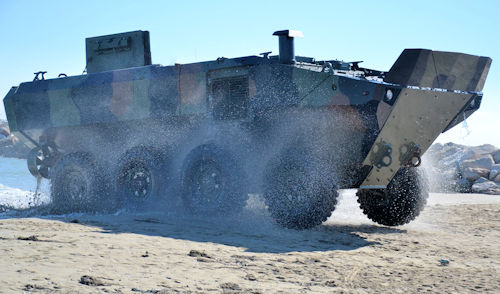
... a full title among the armored amphibians also with sea force 3
The VBA is fully covered by the approval marks Stanag 4569 regarding the safety and ballistic protection of its occupants. Its navigability, despite the mass of 24 tons, exceeds 6 nautical knots (10 km / h) with an engine at 1800 rpm, and the land performances are identical to those of the Centaur you own, think a little, the same mass.
Marine propulsion is produced by a pair of rear propellers on the ground that remain exposed despite being in steel and perhaps this remains a neo if rearranged. Its features, according to the layout, allow it to be used also as a vehicle from command post, communication center or healthcare.
Ground characteristics are comparable to 8X8 - Actl vehicles, Centaur e Arrow - for which I will not be able to reproduce already widely documented news, but rather I would like to focus on the particularities of some technical aspects.
A Cursor Engine
It mounts an Iveco Cursor 13 engine that develops 560 horses, the same as mounted on the international version of the Atlas SM, but which has been extensively equipped as standard on the Iveco truck Stralis. Its maximum speed is about 100 km / h with an autonomy of 500 kilometers. The gearbox is a classic automatic 7 ratio, designed by ZF in conjunction with IDV and also around the 1200 revolutions, the hydraulic torque converter excludes creating a rigid ratio between engine and wheel revolutions. In addition to the traction block and differentials, ABS and ASR are also available, if not possible.
The transmission system in H
It is perhaps more interesting and less discussed. It is probably an Italian patent and the system allows to transmit the bike to all 6 or 8 wheels without occupying too much space in the cabin, but maintaining vehicle height and stability in optimal parameters.
Other foreign production of this kind is in fact increased to drive the transmission shaft centrally to the vehicle, and this can result, due to the higher height, of stability problems in fast road driving.
The H system takes its movement at the exit from the forward gear, and here a splitter divides it onto two light alloy trees that run along the sides of the VBA. At the wheels, where there is the point of attachment of pneumatic hydraulic shock absorbers, a mechanical retractor system moves from the transmission to the wheel.
Some foreign products use hydrostatic pressure systems in the order of 250 bar, relying ultimately on the operation of construction excavators.
The success of the project
The VBA finds its space at the top of the AVV7 and the 'ARISGATOR and this project was greatly appreciated not only by the Marine Corps but also from various armies around the world that are increasingly showing interest in the production of CNH Iveco Defense.
Vehicles of this kind, like the Swiss Mowag Piranha, see a major commitment also in the armies of Latin America, where waterways and rivers are widespread. Colombian police use them during the harsh reprisals against Narcos, drug traffickers who often respond without too much trouble to the militia with warfare like the M60 machine guns.
A very good project for VBA even though a few specimens were produced. It could be the antechamber for the amphibious creation of the Centaur or perhaps of Arrow.
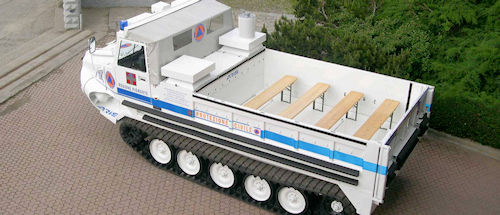 ARK, a not necessarily military logistics but in the footsteps of the M113
ARK, a not necessarily military logistics but in the footsteps of the M113
Produced by Aris in the province of Turin is an unprotected but crawled vehicle and for this reason it can have a really good mobility on any bottom.
Its cockpit reminiscent of a "snow cat" is equipped with a large body for carrying people or materials. However, it is inspired by the proven efficiency for the military world that has demonstrated the log cab M 548, a relative more and, too of the M113, which we all know by now (v.articolo). However, Aris also produces an amphibious version,ARISGATOR, an amphibious revision of the M113 supplied to the Italian Army
Appreciated and indispensable, his tracks do not betray expectations
Civil Protection, Armed Forces, Firefighters give the ARK a delicate task, especially when it comes to using it as an alternative to the helicopter, perhaps to look for missing.
The engine
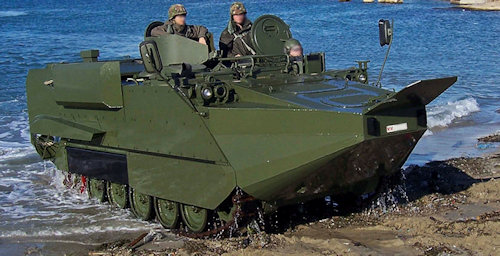
It was not easy to get this news, which does not exist on the net among other things, but I wanted to offer you something complete, at least for fans of the sector. I understood, without certain data, that it could be an engine similar to that of the M548 or M 113 but when the article was completed, the news came from Aris. It is therefore an engine produced by Detroit Diesel with naturally aspirated six-cylinder 5.0 cc for about 212 horsepower. It should be emphasized that this type of apparatus can also reach 8.0 cc. In the USA it is often set up on big Kenworth trucks but also on Greyhound lines buses, the ones with aluminum bodywork that we often see in movies. Its gearbox, on the other hand, is an Allison 4-speed automatic and both engine and gearbox - now we can tell - are also assembled on the M548 and M113 from which the Ark originates.
It has two hydro-jets with turbines driven by the oil pressure placed on the front sides and when pressurized the ARK rises, as if breathing, the front of the engine and its navigational speed reaches the 6 knots, 10 km / h, keeping an optimal torque.
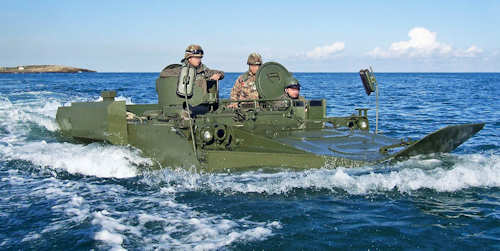 The strong point of the SHARK, however,off road, where its tracks do not betray expectations. Stability is given by a not pronounced keel, but sufficient to not tilt it in the float. Suitable for both sea and rivers, its structure is light alloy and as soon as it touches the ground, propulsion stops passing its strength to the tracks. In the water you drive with a simple joystick, while on the ground there are the two brake levers like the M113 and an Allison automatic gearbox.
The strong point of the SHARK, however,off road, where its tracks do not betray expectations. Stability is given by a not pronounced keel, but sufficient to not tilt it in the float. Suitable for both sea and rivers, its structure is light alloy and as soon as it touches the ground, propulsion stops passing its strength to the tracks. In the water you drive with a simple joystick, while on the ground there are the two brake levers like the M113 and an Allison automatic gearbox.
The set-up can take on the configurations of logistic cargo, for forest interventions or for transporting people. Almost seven meters long, it is as wide as a bus, 2,55 meters, and has a service range of 500 kilometers.
Even for tourism the amphibious goes great
In Hamburg, on the Elbe river, Germany, Austria, but also in Lisbon on the Tagus and Arno in Florence - where the municipal junta is thinking - it is not uncommon to see an atypical boat floating with bright and colorful livery and with aboard surprised and entertained tourists. Let's not be scared, because in these countries it is normal to see a coach floating on the water while browsing the most suggestive locations.
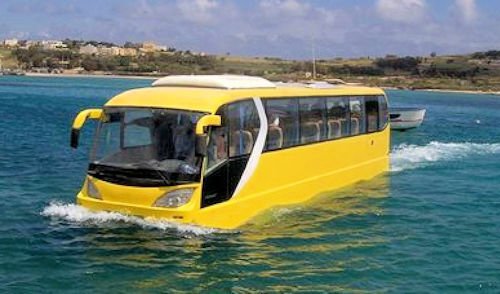 A bus and not a vaporetto, which circulates through the city streets, making its normal stops, but all of a sudden it takes a slide and takes off into the waterways continuing its run or perhaps it would be better to call it "navigation".
A bus and not a vaporetto, which circulates through the city streets, making its normal stops, but all of a sudden it takes a slide and takes off into the waterways continuing its run or perhaps it would be better to call it "navigation".
Amphi Coach GTS 1, is the first 12 meter bus to navigate lakes and rivers at a full speed, just over 20 knots, about 40 km / h. On the road can reach 120 km / h 50 people as a bus of the same category, but beware, since over 8 tons of mass its road speed is limited to 100 km / h.
It is built on Iveco platform and its engine is the robust NEF Tector from 250 or 300 horses, the smallest version of this engine is the same as applied to the Sitcom bus from 40 used in the Armed Forces. Our amphibian rests on Iveco's mechanics Job and has the integral traction that can be inserted while the thrust in the water is guaranteed by two hydro jets similar to those of the water motors. But in the project, there is an electric water system to make this bus even more ecological and economical.
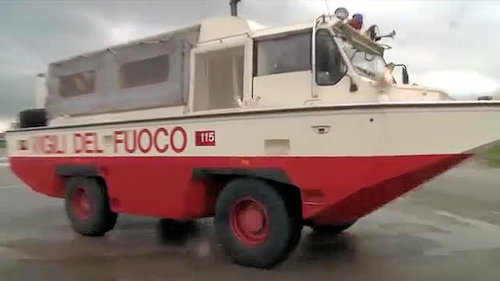
Iveco 6640G 4x4, an elevated and falling ACM 80 in water ...
With a proven mechanics, the same as ACM 80, Iveco with Magirus is on the field or maybe it's better to say, "in the water" with a widespread two axes when it comes to civil protection and defense.
The 6640G 4X4 is amphibious and motorized with the historic 5.499 cc engine with 195 horses and 5 gears that allow it with longer reports a road speed of 110 km / h, and thanks to its 2 hydro jet turbines, it exceeds 11 knots .
Enlisted with full marks in the National Firefighters' Corps and civil protection has a payload of more than two tons, but beyond its "aquatic" characteristics it is interesting to pull the power of its winch, which can work hard up to four tons and a half. Its crew is made up of three operators and can carry in shape with box, about 10 additional people.
VM 90 "Sealand" has arrived in Corsica, navigating ...
If the previous vehicle made the right honors to ACM, the chameleon VM 90 could make it to Iveco Daily, in fact Sealand "Embodies" the amphibious version of this multitasking project and at first glance it looks like a smaller version (in fact) of 6640G 4x4. But I'm structure, cabin, and front to betray "the chameleon VM90" by making us understand that we are right in front of Multivolume Vehicle 90 in use to the Armed Forces.
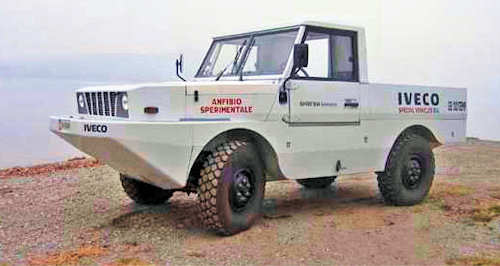
It has all the road characteristics and off road of the military VM, with engine tested in 2.5 and 3.0 cc with respectively 105 and 150 cv; anterior traction insertion thanks to two differentials and a central distributor with a smaller 5 gearbox and a rear propulsion unit with spoons at the end of the jet mouths, maneuverable with a joystick from the driver's seat, which according to their orientation, divert the flow of water under pressure to change direction. It has an additional tank of 300 liters that allows it to be "earth-water" with all respect.
His testing, edited by engineer Maurizio Zanisi of Milan, saw the prototype Sealand engaged in crossing the Corsica channel in 14 hours for approximately 75 nautical miles, 140 kilometers. The engineer also said with satisfaction that a wealthy customer from Belgium wanted a specimen of this prototype on board his ship to explore the wonderful islands encountered while sailing to Australia after slipping into water from the huge boat platforms.
Acknowledgment to firefighters and military logistics
When we meet or see these white and red or green vehicles on the news, generally the association with the event is certainly not the happiest. I therefore believe it is right to give the firefighters all the deserved recognition for the skills that make them indispensable and always extraordinary. The same applies to all the soldiers involved in the incessant work of Army logistics, a reality perhaps less in sight, but the first to arrive and the last to leave, like the civilian professionals of the Auxiliary Corps, who offer their indispensable contribution by putting in place, when recalled, their civil competence for the defense of the country.

